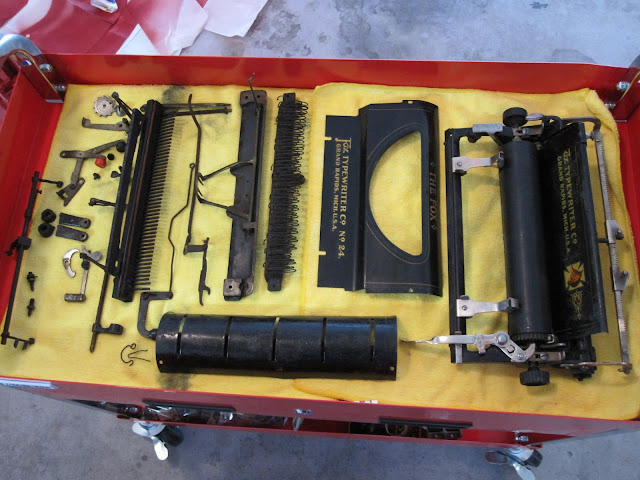The hours became blurred; the day turned to night. And still my adversary, the great black fox, eluded me. Until dawn crept on the third day of the hunt, and we spotted the great beast in the thick of the woods. It was a mighty battle, fraught with terror and madness, but in the end we prevailed; The mighty Fox was brought to its end.
Or, at least, taken apart. I have disassembled quite a few machines, but none put up such a fight as this Fox. Putting it back together will take some ingenuity because my process for taking it apart at a point turned into "lets just unscrew whatever we can and go from there." The main issue with taking these buggers apart is that the back-top of the frame is also screwed to the central support in such a way that you cannot unscrew the two unless almost everything is out of the way. Due to that, and the fact that the central support holds the shifting rod and the key-lever action rod, on top of the fact that they used pins in a lot of the fastening rather than screws, makes the whole thing chaotic.
I have also noted some reasons why we can assume the machines profit margin was lower than the competition, such as Underwood. Rather than rely on any sort of slotted segment for any part of the entire mechanism, higher quality, though more expensive, alternatives are used. The key levers are screwed into a back plate via a small pivot on the end of each bar, the screws being within larger hollowed out screws (honestly, it's hard to figure what they were thinking back then.). The action-levers are separated individually by fancy washers that are partially hollowed to reduce friction. The type-bars are not just staggered, they're double staggered, and I cannot even begin to explain that, and alongside being double staggered the design has every other typebar conjoined with its "brother" with a metal piece. I can only assume the point of it all was to ensure absolutely permanent and perfect alignment no matter what.
On the side of ingenuity, the shifting tension can be adjusted by turning a screw on the right side of the machine (accessed from the back, so it will be to the left) which is part of a worm-gear system. Due to the pins on certain features, alignment of parts is guaranteed to always be perfect.
And, to top it all off, due to the highly expense route they went with, I can say matter of factly that the design of the Fox allows for the lightest touch possible. Only the springs create any resistance, and they are necessary to ensuring the typebar retreats properly. If your Fox doesnt have the lightest touch you've ever experienced, its either not oiled properly, got some gunk in pivot points, or something.
Now then, here's the current state of the Fox in what I have dubbed the "Fox Operation Zone";
I'm still working on getting the ribbon-advancement rod out. Its gears are pinned, and they aren't budging yet.
On the floor, the Underwood has just received its new layer of shiny Regal Red.
The "Underwood Operation Zone". I'll be working on both machines at roughly the same time, but emphasis for now is on the Underwood. I desire to use it for the upcoming "NaNoWriMo"
And finally, between the two operational zones, the actual cleaning and fixing zone, with radio.
Stay tuned for more updates on the Great Black Fox, and the Imperial Underwood.





Another great post, as the tension on both fronts mount (no pun intended). I'm sure the results will be sublime, and the value these machines will hold for you incomparable.
ReplyDelete~Joe
I always grow attached to the machines I do the most on. Something about the investment in time that makes it worth more to me than anyone could offer. Machines I don't do anything but clean without taking apart are the reciprocal to that. They are the ones I end up selling.
DeleteWell, if nothing else, you have a lot of very small parts. :D
ReplyDeleteI have a bucket filled with small parts that, at this point, I cannot remember from whence they all came. I have enough screws to build a new typewriter, but I only have two parts machines, and they are still relatively whole... where did they all come from!?
DeleteIncredible progress on the Fox in just a couple days. So nice to see all those dirty, rusty parts out and ready for a good scrub down. That Fox is so dense with little parts, I knew that its best chance for proper rehab would be to send it to someone who could tear it apart. It typed very well for me after some rust removal - I can only imagine what it will type like after you're through with it.
ReplyDeleteThe fox is, once broken down, actually a very simple design in regards to its escapement and actual function. The escapement has probably less than half the number of parts which the Underwoods escapement has. I think, had Fox been able to produce a desktop with the slotted segment design, it would have taken the market by storm as a very fast (and profitable) machine
DeleteScrews within screws? My mind is boggled.
ReplyDeleteI've determined that the hollowed out larger screw is for setting the height of the back-end of an individual keybar, and the smaller screw that then goes in the larger hollowed one actually locks the keybar in place. The potential for fine adjustments on these machines is incredible.
Delete